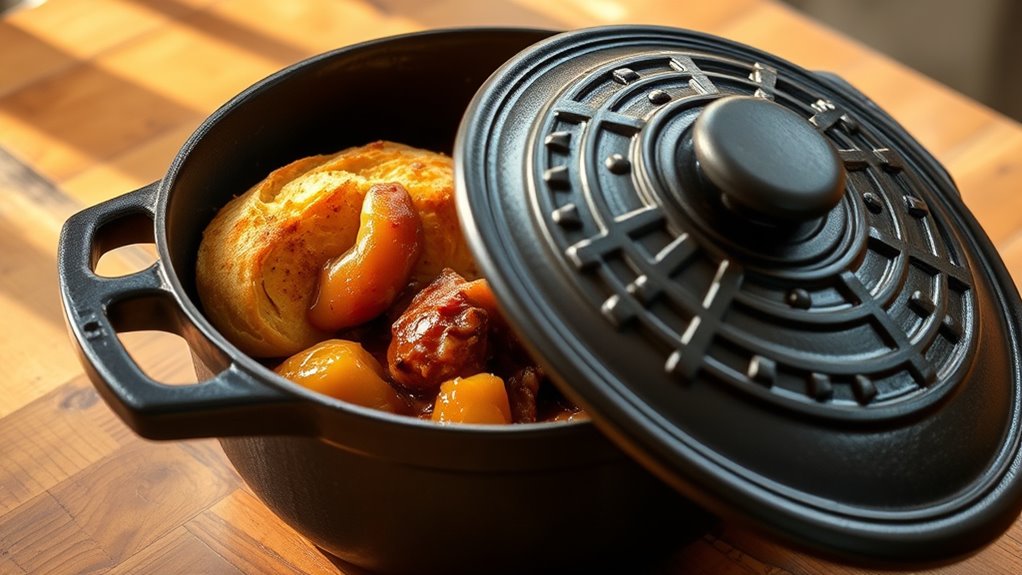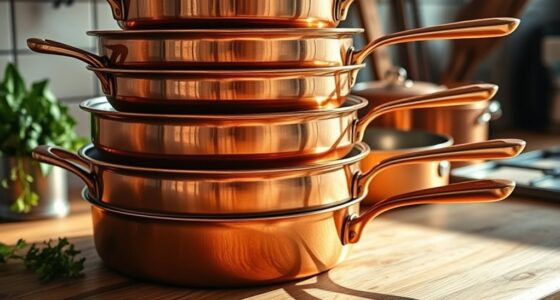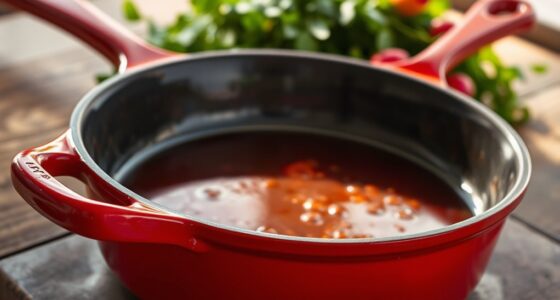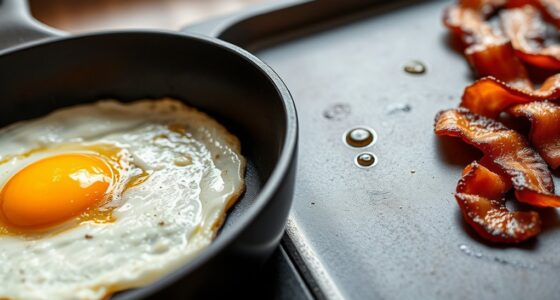A Dutch oven is a versatile tool perfect for baking bread, braising meats, and roasting dishes. Its cast iron construction provides even heat distribution and retains high temperatures, enhancing flavors and textures. To get the best results, maintain a proper seasoning layer, keep it clean and dry, and apply oil after each use. With proper care, you’ll open its full potential for a variety of delicious meals—keep exploring to discover more tips and techniques.
Key Takeaways
- Use a well-seasoned cast iron Dutch oven for versatile baking, braising, and roasting, ensuring even heat distribution.
- Preheat the oven with the Dutch oven inside to achieve optimal baking and browning results.
- Maintain a proper seasoning routine to prevent sticking and enhance flavor during bread and braise cooking.
- Keep the Dutch oven clean and dry after each use, applying a light oil coating to preserve the non-stick surface.
- Adjust cooking times and temperatures based on the recipe to optimize bread crust, tender braised meats, and baked dishes.

Have you ever wondered what makes a Dutch oven so versatile in the kitchen? It’s primarily because of its durable cast iron construction, which allows it to handle a variety of cooking methods, from baking bread to braising meats. But to truly unlock its potential, you need to understand cast iron care and seasoning techniques. Proper maintenance ensures your Dutch oven remains non-stick, rust-free, and efficient for years to come.
Discover how cast iron care and seasoning unlock your Dutch oven’s true versatility and longevity.
When it comes to cast iron care, the key is to keep your Dutch oven clean and dry after each use. Avoid soap, which can strip away the seasoning, and instead, scrub it with hot water and a stiff brush or a scraper if needed. Dry it thoroughly—moisture is the enemy of cast iron because it can cause rust. Once dry, apply a light coat of vegetable oil or shortening to the interior surface. This step is essential for maintaining the seasoning layer and preventing rust. Regular seasoning enhances the non-stick qualities of your Dutch oven, making your baking and braising much easier.
Seasoning techniques are the backbone of cast iron cookware longevity. To season your Dutch oven, start by preheating your oven to around 450°F. Apply a thin, even layer of oil all over the inside and outside of the pot, paying special attention to the cooking surface. Place it upside down in the oven—placing a sheet of aluminum foil on the rack below catches any drips—and bake for about an hour. Let it cool completely before using. Over time, this process builds a natural, durable non-stick coating that improves with each use. The more you season your Dutch oven, the better it will sear, bake, and braise, creating a naturally non-stick surface that enhances flavor and reduces sticking.
Understanding cast iron care and seasoning techniques will help you get the most out of your Dutch oven. With proper maintenance, your pot will develop a rich, black patina that improves performance and appearance. This means fewer sticky spots, easier cleaning, and a utensil that can handle high heat for baking bread, slow braising, or roasting. Regularly maintaining the seasoning is crucial for longevity and performance. Remember, the care you give your Dutch oven today sets the foundation for its future versatility. With a little effort, you’ll enjoy perfectly baked bread, tender braised dishes, and baked goods that have a beautiful crust—all thanks to a well-maintained cast iron Dutch oven.
Frequently Asked Questions
How Do I Properly Clean and Maintain My Dutch Oven?
To properly clean and maintain your Dutch oven, rinse it with warm water and avoid soap to protect the seasoning. Use a brush or scraper for stuck-on food. After cleaning, dry it thoroughly to prevent rust and apply a light coat of oil for seasoning maintenance. Store it in a dry place, and if rust appears, gently scrub it away and re-season to keep your Dutch oven in top shape.
Can I Use My Dutch Oven on an Induction Cooktop?
Yes, you can use your Dutch oven on an induction cooktop if it’s induction compatible. Check the bottom for a magnetic requirement—if a magnet sticks firmly, it’s suitable for induction. Most cast iron Dutch ovens work well because they’re naturally magnetic. Just guarantee your cooktop settings are appropriate, and avoid dragging the heavy pot to prevent damage. With the right compatibility, you’ll enjoy even heating and great cooking results.
What Are Some Common Mistakes to Avoid When Baking Bread?
When baking bread, avoid overproofing your dough, which can lead to a dense texture. Also, guarantee your Dutch oven heats evenly; uneven heat distribution causes inconsistent crusts and underbaked spots. Don’t rush the proofing process, and preheat your Dutch oven thoroughly. Using a thermometer can help monitor temperature. These steps help you achieve a perfect loaf with a crusty exterior and soft interior.
How Do I Prevent My Dutch Oven From Cracking?
To prevent your Dutch oven from cracking, you need to respect its durability, prioritize cast iron safety, and avoid sudden temperature changes. Always preheat gradually, avoid placing a cold Dutch oven into a hot oven, and never pour cold liquids into a hot pot. Handle with care, use oven mitts, and guarantee proper seasoning. These practices protect your Dutch oven and maintain its lifespan, ensuring safe, effective cooking every time.
What Are the Best Accessories to Enhance Dutch Oven Cooking?
To enhance your Dutch oven cooking, consider useful accessories like silicone handle covers, trivets, and cast iron lid lifters. These make handling hot cookware safer and easier. Also, invest in high-quality Dutch oven accessories such as enamel repair kits or protective liners to extend its lifespan. Remember, proper seasoning tips like oiling and baking your Dutch oven regularly help prevent rust and improve performance, ensuring your accessories work even better.
Conclusion
Now that you’ve uncovered the secrets of your Dutch oven, you’re equipped to turn simple ingredients into culinary magic. Think of it as your trusty vessel, transforming everyday moments into a warm, inviting hug. Whether you’re baking bread, braising meats, or roasting vegetables, your Dutch oven is your culinary compass. So, explore with confidence—because with this versatile tool, every meal becomes a masterpiece waiting to happen. Happy cooking!









